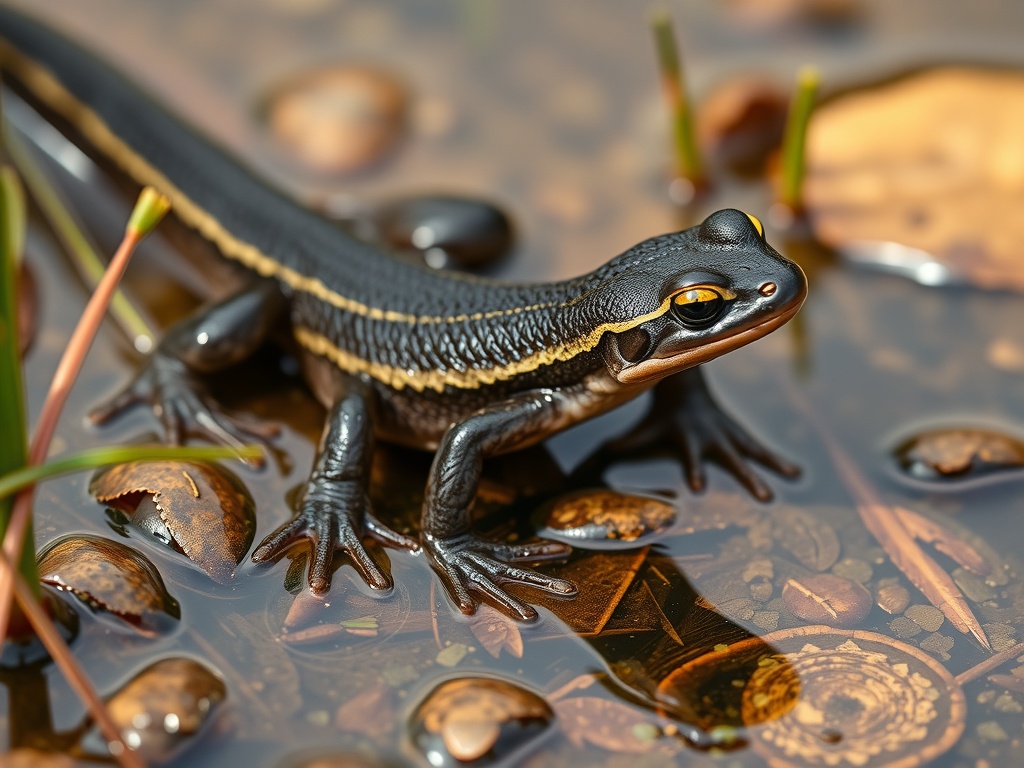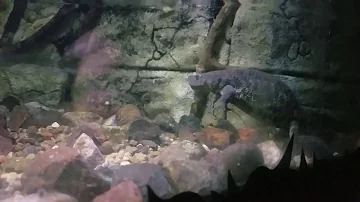
Sharp-ribbed Newt
Pleurodeles waltl

Meet the Sharp-ribbed Newt
The Sharp-ribbed Newt, also known as the Iberian ribbed newt, is a large aquatic amphibian native to the Iberian Peninsula and Morocco. It is renowned for its unique defense mechanism, in which its sharp ribs can puncture through its skin to secrete toxins and deter predators. This newt has a robust, olive-brown body with small orange spots running down its sides, and it can grow up to 30 centimeters in length. The species is highly aquatic, often found in slow-moving or stagnant freshwater bodies such as ponds and marshes.
Classification
Amphibian
Habitat
Freshwater ponds, marshes, and slow-moving streams
Diet
Carnivore
Lifespan
5-11 years
Conservation
Near Threatened
Weight
20-50 grams
📖Fascinating Facts
Unique Defense Mechanism
When threatened, the newt can thrust its sharp ribs through its skin, coating them with a toxic secretion to repel predators.
Aquatic Lifestyle
Sharp-ribbed Newts spend most of their lives in water, rarely venturing onto land except during periods of drought.
Regeneration Abilities
They possess remarkable regenerative powers, capable of regrowing limbs, tail, and even parts of internal organs.
📋Detailed Description
The Sharp-ribbed Newt (Pleurodeles waltl) is the largest European newt, with adults typically reaching 15–30 cm in length, though exceptional individuals may exceed this. Its body is robust and dorsoventrally flattened, with a broad, rounded head and small eyes lacking eyelids. The skin is smooth and olive to brownish-gray, often mottled, with a distinctive row of small orange or yellowish tubercles running laterally along each side. These tubercles mark the points where the ribs can protrude during its unique defensive display. Limbs are relatively short but strong, with four fingers on the forelimbs and five toes on the hindlimbs. The tail is laterally compressed, facilitating efficient swimming. Pleurodeles waltl is highly aquatic, rarely leaving water except during periods of drought. It is primarily nocturnal, spending daylight hours concealed among aquatic vegetation or under debris. The species is long-lived for an amphibian, with lifespans in captivity exceeding 10–15 years. Its respiratory system is highly adaptable, utilizing lungs, gills (in larvae), and cutaneous respiration to meet oxygen demands in variable aquatic environments.
💡 Did you know?
Unlike most amphibians, Sharp-ribbed Newts can regenerate not just limbs, but even parts of their heart and eye tissue.
🔬Research & Sources
Wikipedia Summary
The Iberian ribbed newt, also known commonly as the Spanish ribbed newt and el gallipato in Spanish, is a species of salamander in the subfamily Pleurodelinae of the family Salamandridae. The species is native to the central and southern Iberian Peninsula and Morocco. It is the largest European newt species. It is known for its defense mechanisms where their sharp ribs puncture through its sides when in a defensive state, and as such is also called the sharp-ribbed newt and the sharp-ribbed salamander.
Last Modified: 5/23/2025
🎭Behavior & Social Structure
Sharp-ribbed Newts are solitary outside the breeding season, exhibiting minimal social interaction except during courtship. They are opportunistic carnivores, feeding on a variety of invertebrates (worms, insects, crustaceans) and occasionally small vertebrates such as tadpoles or fish fry. Hunting is primarily ambush-based, with the newt remaining motionless until prey approaches, then lunging with a rapid extension of the tongue. They are most active at night, foraging along the substrate or among submerged plants. During the day, they seek shelter to avoid predation and desiccation. In response to threats, they display thanatosis (feigning death) or, more famously, arch their back and force their sharp ribs through the skin, secreting a mild toxin to deter predators. Outside the breeding season, individuals are territorial, but aggression is rare and usually limited to posturing.
👶Reproduction & Life Cycle
Breeding occurs primarily in late winter to early spring, triggered by rainfall and rising water levels. Males court females through tactile and chemical cues, performing a tail-fanning display to waft pheromones. Fertilization is internal: the male deposits a spermatophore on the substrate, which the female picks up with her cloaca. Females lay between 100 and 1,000 eggs, attaching them singly or in small clusters to aquatic plants or debris. Embryonic development lasts 7–15 days, depending on temperature. Larvae are fully aquatic, with external gills and a carnivorous diet. Metamorphosis occurs after 2–4 months, but in some populations, larvae may overwinter or even retain larval features into adulthood (paedomorphosis), especially in permanent water bodies. There is no parental care after egg-laying.
🛡️Adaptations & Survival
The most remarkable adaptation of Pleurodeles waltl is its rib-based defense mechanism: when threatened, the newt contracts its body muscles to force the sharp tips of its ribs through the skin at the lateral tubercles, simultaneously secreting a milky toxin from skin glands. This unique adaptation deters many predators and is virtually unique among vertebrates. The skin is highly permeable, facilitating cutaneous respiration, and the species can tolerate low-oxygen environments by increasing skin and buccal respiration. Pleurodeles waltl is tolerant of a wide range of water conditions, including high salinity and pollution, allowing it to persist in degraded habitats. Its ability to aestivate (enter a dormant state) in mud during droughts enhances survival in arid regions.
📚Research Sources
🎨Cultural Significance
In Spain, the sharp-ribbed newt is known as 'el gallipato' and features in regional folklore as a symbol of resilience and transformation. It has been used in traditional medicine and, more recently, has become an important model organism in scientific research, particularly in studies of regeneration, as it can regrow limbs, tail, and even parts of the heart and eye. Its unique defense mechanism has inspired interest in biomimetics and toxin research.
🔬Recent Research & Discoveries
Pleurodeles waltl is a prominent model for developmental and regenerative biology due to its exceptional regenerative capacity. Recent genomic studies have sequenced its large genome (over 20 Gb), providing insights into the genetic basis of regeneration and immune response. Studies have also investigated its resistance to infection and its unique rib defense mechanism, revealing specialized skin gland adaptations and immune responses that minimize self-injury. Conservation genetics research is ongoing to assess population structure and genetic diversity, particularly in fragmented habitats. The species is also used in ecotoxicology to assess the effects of pollutants on amphibian health.
🎥Wildlife Videos

The Iberian Ribbed Newt
Incredible!! #animals #wildlife #animalfacts #nature #facts #YouTube #africa #africanwildlife #europe #europeanwildlife ...
WinterWolf

The Bizarre Beast with Pointy Ribs
The Iberian ribbed newt likes doing regular newt things, like living in ponds and eating worms. But when they're threatened by a ...
Bizarre Beasts

Sharp Ribbed newt
The Bloody English

Sharp-Ribbed Newt
Sid Arthur

Sharp ribbed newts in outdoor pond during winter in North Wales
The Bloody English

Adult Sharp Ribbed newt
The Bloody English
🌍Habitat Information
The Sharp-ribbed Newt typically inhabits Freshwater ponds, marshes, and slow-moving streams environments. Sharp-ribbed Newts have adapted to their environments with specialized features and behaviors.
Primary Habitat:
Freshwater ponds, marshes, and slow-moving streams
More detailed habitat information will be available soon.
🛡️Conservation Status
The Sharp-ribbed Newt is currently classified as Near Threatened. Conservation efforts are crucial for preserving this species for future generations.
Common Threats:
- 🏠Habitat loss and fragmentation
- 🌡️Climate change impacts
- 🎯Hunting and poaching
- 🏭Human-wildlife conflict
⚠️Threats & Conservation Challenges
Despite being listed as Least Concern by the IUCN, Pleurodeles waltl faces significant regional declines due to habitat loss, pollution, water extraction, and the introduction of invasive species such as predatory fish and crayfish. Agricultural runoff and urbanization degrade breeding sites, while climate change increases the frequency of droughts, reducing available aquatic habitats. Collection for the pet trade and laboratory research has also impacted some populations. Disease, particularly chytridiomycosis caused by the chytrid fungus (Batrachochytrium dendrobatidis), poses an emerging threat. Population trends are stable in some protected areas but declining elsewhere, especially in Morocco.
🔬Scientific Classification
Scientific Name
Pleurodeles waltl
Classification Hierarchy
🔍 About Taxonomic Classification
Taxonomic classification is a hierarchical system used by scientists to classify and organize living organisms based on shared characteristics and evolutionary relationships.
The system moves from broad categories (Kingdom) to increasingly specific ones, with each animal's scientific name typically consisting of its Genus and species.
📝Community Notes
Share your observations and insights about the Sharp-ribbed Newt with our community of wildlife enthusiasts.
Join Our Community
Sign in to share your observations and connect with fellow wildlife enthusiasts.
Sign In to ContributeNo community notes yet
Be the first to share your observations about the Sharp-ribbed Newt!
Explore Sharp-ribbed Newt
Select a tab above to learn more about this amazing animal.
📸Photo Gallery
No photos available for this animal yet.
🌟Discover More Wildlife
Continue your journey of discovery with more fascinating animals from our database
